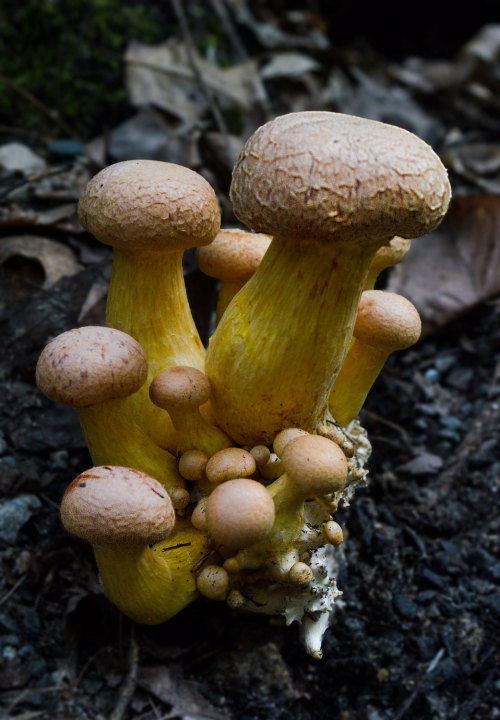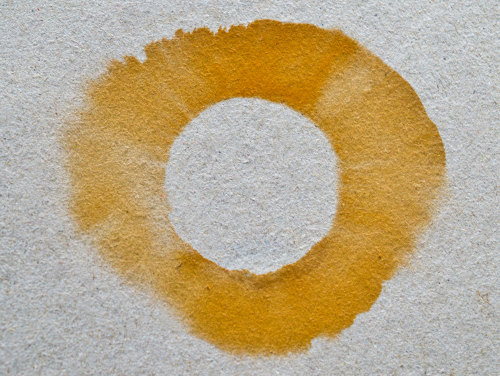The Big Laughing Gym - ( Gymnopilus junonius ) This species was formerly known as Gymnopilus spectab
The Big Laughing Gym - ( Gymnopilus junonius ) This species was formerly known as Gymnopilus spectabilis As you can see in the pictures I cut the biggest mushroom in the cluster out when they were immature to bring home to identify. I then returned after three days to take photographs of the mature mushrooms…. and maybe…This mushroom can easily be mistaken for the dreaded Jack O Lantern mushroom. The woman who wrote Sensual and Amusing: An Ideal Combination (personal experience #2) (at bottom of this page) calls the Jack O Lantern mushroom mildly toxic. It’s not deadly, but it is definitely a mushroom you do not want to ingest! It will put you through the ringer for a few days! The Jack O Lantern mushroom has a nice look and a pleasant smell. So you have to be aware of this particular mushroom so you won’t be fooled. The Big Laughing Gym has a veil, the Jack O Lantern does not. The veil is a membrane that covers the gills when the mushroom is young (2nd picture). As the mushroom gets older the cap opens up exposing the gills leaving a ring on the stem. The Jack O Lantern has a cream white spore print and the Big Laughing Gym has an orange to rust color spore print (last picture). I urge you to read about the two personal experiences of the authors detailed in the links below. Lookalikes: Honey Mushroom (Armillaria mellea) is honey-colored with a white spore print. The Ringless Honey Mushroom (Armillaria tabescens) is honey-colored with a white spore print, and has no ring. Jack-o’-lantern (Omphalotus illudens) lacks a veil and has a whitish-cream spore print. Deadly galerina (Galerina autumnalis) is smaller and browner. Description: Large, clutered, yellowish-orange mushroom with ringed stalk; on wood.Cap: 3.25-7 inches or 8-18 cm wide; convex and knowbbed to nearly flat; smooth, slightly silky-fibrous or with minuyte scales; light orange-yellow to ochre-orange. Flesh thick, yellowish. odor aniselike or mild; taste very bitter.Gills: attached, crowded, narrow to moderately broad, pale yellow to rust.Stalk: 2-8 inches or 5-20 cm long, 1-3 cm thick; solid, pale yellow to ochre, streaked with minute fibers.Veil: partial veil thin and membraneous to fibrous, pale yellow; leaving indistinct, evanescent ring or zone on stalk; ring sometimes persistent, high.Spores:7.5-10.5 X 4.5 - 6 m; oval to elliptical to almond shaped, winkled. Spore print orange to rust-orange.Edibility: Hallucinogenic.Season: August to October Big Laughing Gym info… (personal experience #1)Geography: North Eastern US (Virgina and north) / Japan[Also found in Western US, however for some reason the western varity is not psycoactive enough to be considered for consumption (besides, you guys out west have enough fun mushrooms growing wild)] ;) Sensual and Amusing: An Ideal Combination (personal experience #2)While enjoying a pleasurable evening walk on my property, I stumbled across a clump of large, orangish mushrooms. I was initially inclined to dismiss them as Jack O’ Lanterns, a beautiful yet mildly toxic (and certainly not psychoactive) mushroom common to my area. However, upon having a closer look, these particular mushrooms did not possess the typical characteristics of Jack O’ Lanterns, and more so resembled Gymnopilus. I decided to collect a few of the caps and bring them home for a spore print, in a hopeful attempt to confirm them as Gymnopilus Junonius. All Photographs by Gary Cremese -- source link
#wild mushrooms#mushroom hunting#hallucinogenic mushrooms#mushroom identification#photography





